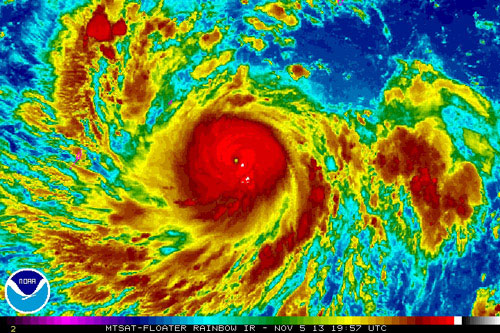The difference between the names of storms
Hurricane, cyclone and typhoon are all words used to describe storms, but the use of different names depends on where the storm was formed and appeared.
>>>Scary phenomena can happen in super storms
Hurricane, cyclone or typhoon
In fact, hurricane, cyclone or typhoon are words used to talk about big sea storms when landing and attacking many parts of the world, the difference in the use of names is based only on Different locations and occurrences of these storms.
The Hurricane is the word used to refer to the sea whirlwinds in the Atlantic, Caribbean, central and northeastern Pacific regions. The Hurricane is based on the name of an evil god of the Caribbean Sea called Hurricane.
In the Pacific Northwest, similarly powerful storms are called typhoon . Meanwhile, cyclone refers to storms that form and occur in the South Pacific and Indian Ocean.

Images of super typhoon Haiyan when preparing to land in the Philippines.This is considered the strongest storm in the world this year.(Photo: NOAA)
The power of storms
The storms are named and considered tropical storms with a wind speed of 63km / h and are classified as hurricane, typhoon or cyclone when reaching 119km / h.
According to the Saffir-simpson hurricane scale, the classification of storms used for tropical cyclones in the Western hemisphere has intensity exceeding the intensity of tropical depressions and tropical storms, with 5 levels to distinguish the storm according to wind intensity. The highest in the hurricane scale is level 5 with storms with winds above 250km / h.
The number of strong storms ranked on April 4 and 5 worldwide has nearly doubled since the beginning of 1970 until 2000. The duration of the storm and the strong winds of tropical storms have also increased. 50% in the past 50 years
Super typhoon Haiyan landed in the Philippines on November 8 with an average wind speed of 320km / h, ranked in a Category 5 hurricane ladder, considered the strongest storm in the world this year.
The direction appears
In the northern hemisphere, the shifting wind must cause the storms to appear north of the equator to rotate counterclockwise and vice versa, when it appears in the equator, the storms will rotate clockwise.
Storm season
The storms that occur in the Atlantic and Pacific Ocean usually last from the beginning of June to the end of November. The typhoon season in the Eastern Pacific starts from May 15 and ends on November 30 every year. From November to April next year is the hurricane season in the South Pacific and Australia. The Bay of Bengal has two hurricane seasons of the year, from April to June and from September to November. Typhoons form in the Pacific Northwest almost every month of the year.
The western Pacific hurricane belt area is where storms often occur, averaging about 27 storms named each year. Located within the western Pacific typhoon belt, the Philippines suffers about 20 storms annually.
Name the storm
The list of names for the storms proposed by the World Meteorological Organization, the names of the storms are also often named after each area. The names of some storms will be removed from the list and replaced with other names in case it causes a lot of damage and a large number of casualties.
The Philippines has its own storm naming system, so super typhoon Haiyan is also known by another name, Yolanda. In Chinese, the name of the storm is also called Hai Yen.
- The destructive power of a storm depends on the naming?
- How are Pacific storms named?
- Why is 'female storm' more severe than 'male storm'?
- Do you know: Who named the tropical storm?
- The origin 'no one knows - no one knows' in the names of the months
- The most dangerous storms in Vietnam
- Why are vitamins named after letters?
- The easier the name to pronounce, the easier it is to be trusted by others
- The anger of Earth's mother
- What is a storm? How storms form and why do storms occur?
- Cyclone storm, typhoon typhoon and storm tropical storm What's the difference?
- Day and night how much temperature difference affects health?
 'Fine laughs' - Scary and painful torture in ancient times
'Fine laughs' - Scary and painful torture in ancient times The sequence of numbers 142857 of the Egyptian pyramids is known as the strangest number in the world - Why?
The sequence of numbers 142857 of the Egyptian pyramids is known as the strangest number in the world - Why? History of the iron
History of the iron What is alum?
What is alum?